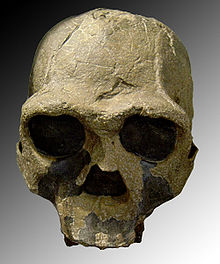loài động vật có vú From Wikipedia, the free encyclopedia
Homo ergaster là một loài đã tuyệt chủng của chi Người từng sinh sống ở miền đông và miền nam châu Phi vào đầu thế Pleistocen. Theo các nguồn khác nhau thì từ khoảng 1,8 tới 1,3 triệu năm trước[2] hoặc từ 1,9 tới 1,4 triệu năm.[3] Hiện nay vẫn còn tồn tại bất đồng về phân loại, tổ tiên, và hậu duệ của H. ergaster, nhưng nói chung người ta chấp nhận rằng loài này là tổ tiên trực tiếp của các dạng người xuất hiện muộn hơn, như Homo heidelbergensis, Homo sapiens, Homo neanderthalensis và có thể cả Homo erectus.[4]
| Homo ergaster | |
|---|---|
| Khoảng thời gian tồn tại: Canh Tân sớm, 2.04/1.95–1.4/0.87 triệu năm trước đây | |
 | |
| Hộp sọ KNM-ER 3733 của loài Homo ergaster đã 1,6 triệu năm tuổi được phát hiện năm 1975 tại Koobi Fora, Kenya | |
| Phân loại khoa học | |
| Vực: | Eukaryota |
| Giới: | Animalia |
| Ngành: | Chordata |
| Lớp: | Mammalia |
| Bộ: | Primates |
| Phân bộ: | Haplorhini |
| Phân thứ bộ: | Simiiformes |
| Họ: | Hominidae |
| Phân họ: | Homininae |
| Tông: | Hominini |
| Chi: | Homo |
| Loài: | †H. ergaster |
| Danh pháp hai phần | |
| †Homo ergaster Groves và Mazák, 1975 | |
| Các đồng nghĩa | |
|
† Telanthropus capensis[1] | |
|journal= (trợ giúp)Seamless Wikipedia browsing. On steroids.
